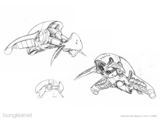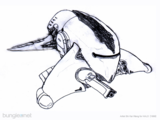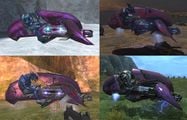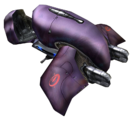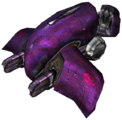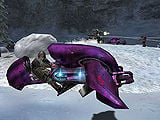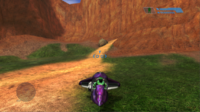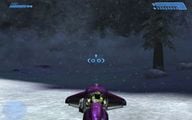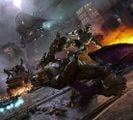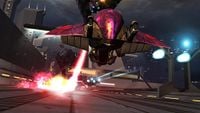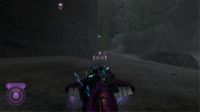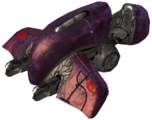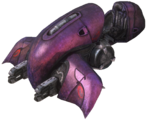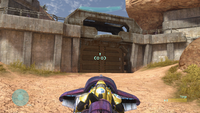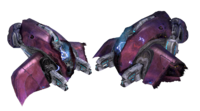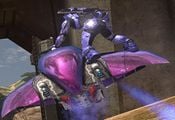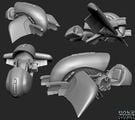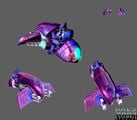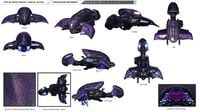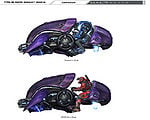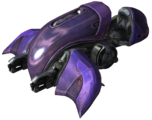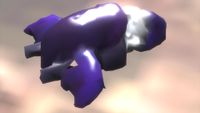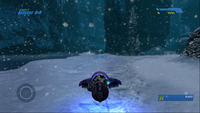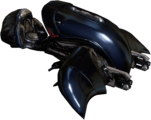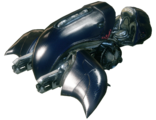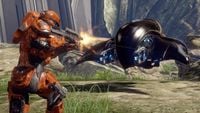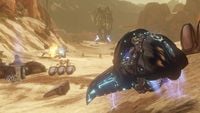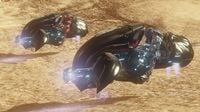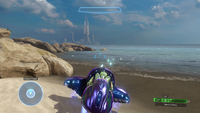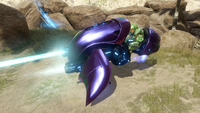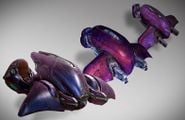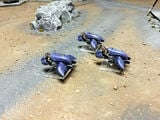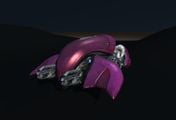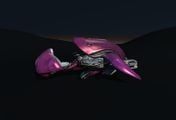Karo'etba-pattern Ghost: Difference between revisions
From Halopedia, the Halo wiki
(→Changes from Halo 3 and Halo 3: ODST to Halo: Reach: Fixed typo.) Tag: Mobile edit |
(→Changes from Halo 3 and Halo 3: ODST to Halo: Reach: Fixed typo.) Tag: Mobile edit |
||
| Line 82: | Line 82: | ||
===Changes from ''Halo 3'' and ''Halo 3: ODST'' to ''Halo: Reach''=== | ===Changes from ''Halo 3'' and ''Halo 3: ODST'' to ''Halo: Reach''=== | ||
The Ghost has been changed considerably from its Halo 3 counterpart | The Ghost has been changed considerably from its Halo 3 counterpart. When enough bullets hit its reactor, it explodes. The plasma cannons become increasingly inaccurate, and the ghost will vibrate while hovering. The Ghost is faster and harder to turn, even without the propulsion system on and responds a little slower when the propulsion drive is turned on, the rear section of the Ghost can now pivot and swing freely as the vehicle executes sharp turns or maneuvers. It can also strafe with the propulsion drive on, but only at a slight amount. Like all other vehicles returning in ''Halo: Reach'', the Ghost has received a visual upgrade, and is now a lighter shade of purple. The propulsion drive can now only be used for a limited amount of time and has a cooldown similar to those of [[Armor Abilities|armor abilities]]. The Ghost also requires less speed to splatter enemies and is much less prone to flipping over. | ||
===Changes from ''Halo: Reach'' to ''Halo 4''=== | ===Changes from ''Halo: Reach'' to ''Halo 4''=== | ||
Revision as of 18:17, June 17, 2020
The Type-32 Rapid Attack Vehicle,[1] more commonly identified as the Ghost by the UNSC, is the Covenant's standard reconnaissance and rapid attack vehicle.
Specifications
Design details
The Ghost is a one-man gravity-effect vehicle, primarily used in a reconnaissance and close infantry support or rapid attack role.[2] Known for its speed and maneuverability as well as its near silent anti-gravity propulsion system the Type-32's use in the field by the Covenant is varied but can adjust very quickly and easily for any role required at any moment.[3] From a design standpoint the Type-32's design is a sleek winged vehicle design more akin to an insect or an aircraft then a ground vehicle. The Ghost is composed of two major components, the fuselage, which contains the Type-32's hardware including its energy weapon system, its anti-gravity propulsion system, imaging, control and guidance systems and fuel as well as its two stabilizing fins. The second part of the vehicle is the seating and guidance section, this multi-joint piece of the vehicle is connected to the pilot's seat and is connected to the fuselage by a ball joint, this aids the pilot in controlling, as the vehicle is controlled as much by weight distribution as it is by steering by use of two joysticks.[3] The pilot is seated in front of a large holographic display console, this console displays the status of the vehicle and controls. Because the Ghost lacks any type of actual viewing window, the largest display on the display console is the video display screen, which shows a wide angle view of what is in front of the vehicle as well as display a targeting heads-up-display. The Office of Naval Intelligence believes that the exposed cockpit was an intentional design by the Sangheili in an effort to display their fearlessness.[4]
The Type-32 RAV is used by the Covenant for a number of different roles, such as patrolling large areas in short amount of time, and to combat infantry when needed. The Ghost can be deployed almost anywhere and can follow Covenant ground troops with ease. The Ghost is propelled by a form of anti-gravity engine known as a boosted gravity propulsion drive,[5] allowing the Ghost to skim above the ground while it is activated. This drive is visible as a bright, fluorescent area of blue energy emanating from the underside of the Ghost. This form of propulsion can accelerate the vehicle very rapidly, reaching speeds of up to 60 kilometers per hour, and up to 90 kilometers per hour when using the boost. By running on its power source and fuel, the Ghost can travel a distance of approximately 950 km or 590 miles,[3] before needing to be refueled. Ghosts have been the vehicle of choice for the Sangheili, though Unggoy can also be seen piloting Ghosts on occasion. Jiralhanae, meanwhile, do not use the vehicle as much, preferring to rely on their own vehicle the Type-25 RAV, but will use a Ghost if needed to.
Armament
The Type-32 RAV is typically armed with two linked forward-firing Class-2 directed energy cannons. These directed energy weapons serve as powerful anti-infantry and anti armor weapons, running on only a small power source.[2] The weapons power output is 100-250 kW.[6] The Class-2 weapon system is used for heavy combat situations and is employed for anti-vehicle combat, but can be extremely effective in infantry support and suppressive roles. The firepower produced by this weapon is considerably high, able to punch through and melt multiple layers of armor until the target vehicles are destroyed, or inoperable. Alternatively, some may be armed with a heavy fuel rod cannon[7] and energy shielding.[8]
Advantages
The fact that the Type-32 RAV can be deployed much faster and in greater numbers on the field than the Type-26 Wraith makes them advantageous as the first attack crafts to be deployed on the field during an operation. Their flexible role allows Ghosts great tactical asset for Covenant ground force commanders as fast, hard-hitting vehicles that can destroy enemy infantry formations, or serve as reconnaissance and scout crafts on human battlefields. The Class-2 energy weapon system is extremely lethal against lightly armored infantry, only requiring one direct hit in order to kill a target. Heavily armored infantry can only sustain a few direct hits before serious injuries are inflicted. The plasma cannons are also extremely effective at destroying vehicles as the heat of the plasma and kinetic energy is able to melt through most light and medium class armor with ease. The Ghost's boosted gravitic propulsion drive allows the Ghost to increase its top speed, allowing for periods of greater velocity. This allows Ghost pilots to enter and leave combat zones rapidly, kill enemies by running them down, and escape more dangerous foes.
Disadvantages
The Type-32s primary weakness is its light armor and exposed cockpit, most anti-armor weapons can easily punch through the armor of the Ghost and destroy it. If the plasma containment vessel of the Ghost is damaged, or breached, a chain reaction can start which will result in the destruction of the vehicle, anything within a certain radius of the Ghost as the vehicle is destroyed by the resulting explosion and the subsequent release of the more than 5000 °C plasma will be incinerated instantly.[9] Anything just outside of the blast radius can also sustain injures by debris ejected from the explosion. The boost propulsion system of the Ghost greatly increases its speed, but because this function diverts energy from the weapon and steering systems, the Ghost is much less maneuverable and cannot fire while boosting.[5] The Class 2 weapon system only has a 150° vertical firing range, meaning that the Ghost has a harder time engaging targets at an elevated angle. The Ghost is also very ineffective in close quarters, due to its blind spot, which makes it vulnerable to return fire, so mid-range is the best range to operate a Ghost. Despite its apparent simplicity and grace, the Ghost requires a skilled driver to handle it properly. Uneven or broken terrain makes the Ghost extremely difficult to pilot.[10]
Operational history
The earliest versions of the Ghost were originally developed by pre-Covenant Sangheili,[1] and the vehicle has been in service to the Covenant since its formation, having served in countless engagements before and during the Human-Covenant War. After the retaking of Harvest in 2526 by Admiral Preston Cole, the Covenant, attempting to scout and recover an relic|artifact, deployed multiple Ghosts to scout areas of interest and slow down advancing enemy forces, during the assault on Harvest.
Throughout the war the Covenant deployed Ghosts during ground campaigns to escort larger vehicles, provide reconnaissance and to engage military and civilian targets at first sight. In 2531 during the first assault on the colony world Arcadia, Ghosts were used to escort larger Wraith tanks to destroy human held positions, killing and causing panic among civilians attempting to flee the Covenant invasion. The RAVs assisted their forces in suppressing infantry and scouting enemy locations to target. In addition the vehicles were used against UNSC military forces attempting to assist with evacuation efforts. During the Battle of the Etran Harborage the Covenant would deploy Ghosts in efforts to stop not only the crew of the UNSC Spirit of Fire but also the Flood and Sentinels too.[8]
As the war dragged on, ground campaigns conducted by the Covenant continued to employ the Ghost as rapid assault vehicles. Late into the war in 2552, the Covenant launched a surprise assault on Reach, humanity's heavily fortified epicenter of military and economic power outside of Earth. Multiple divisions of Ghosts were employed to scout and inflict casualties on civilian and military forces alike.[11] However, when the UNSC Pillar of Autumn escaped, many Covenant ships followed to destroy the Pillar of Autumn. Upon exiting Slipspace, the Pillar of Autumn arrived at Installation 04 and met with multiple enemy contacts. With the Magnetic Accelerator Cannon offline and sustaining extensive damage across all systems, the Pillar of Autumn was forced to crash land on to the construct. Covenant forces deployed Ghosts in order to hunt down the remaining UNSC personnel who escaped onto the ring.[12]
During the opening of the Battle for Earth, Regret's carrier Solemn Penance managed to land in the city of New Mombasa. In the short but bloody campaign the Covenant was able to land armor and troops into the city, Ghosts were utilized in engaging UNSC armor attempting to prevent the Covenant from constructing plasma artillery on the beaches of Old Mombasa, when the UNSC punched through with the assistance of SPARTAN-117, the Covenant tried to block off sections of the tunnels. Type-29 Shadows attempting to fortify Covenant defenses by bringing in Ghosts were ultimately destroyed by the Master Chief. With the UNSC entering the city and civilians cut off the Covenant began systematically destroying anything they could before the Prophet of Regret's ship jumped out of New Mombasa destroying parts the city.[13] In the aftermath of Regret's retreat, the full-scale invasion of Earth began, the Covenant laid waste to many parts of the planet and Ghosts were employed to aid the Covenant in their assault.
As the Battle for Earth raged on SPARTAN-117, with the full support of the UNSC In Amber Clad, launched a counter-strike against Regret who had jumped to Installation 05. Ghosts were deployed in the same manner as they were on Installation 04, however with the threat of the UNSC attempting to stop regret the Covenant relied on more aggressive tactics against their enemy, using Ghosts in tight areas in an attempt to stop the advance of SPARTAN-117. Many more Ghosts would be deployed onto the surface of the installation later in the conflict; many of them would be commandeered by the Flood in the quarantine zone and more would be used by both Sangheili and Jiralhanae forces during the outbreak of the Great Schism.[13]
With the uncovering of the Portal at Voi the Covenant moved all their troops and armor to prevent the UNSC military from getting close to it. They deployed Ghosts in the remnants of Voi to dispatch military forces attempting to break through their formation and even again attempted to squeeze Ghosts in to close quarters in hopes of stalling human forces. This task was ultimately accomplished. After the opening of the portal and the arrival at Installation 00 the Covenant deployed all their assets in a last ditch effort to stop humanity and activate the remaining Halo installations. Ghosts were used wherever possible to halt the UNSC advance towards the Citadel. The Ghosts failed to accomplish this mission and as a result, marked the end of the Covenant.[14]
During the post-war era, Ghosts continued to be used extensively by the various Covenant remnants. Ghosts were popular during War Games matches aboard Anvil Station and the UNSC Infinity. During the Battle of Draetheus V Merg Vol deployed multiple Ghosts to support his troops.[15] Many were seen in action in use by Jul 'Mdama's Covenant during the Battle of Requiem and the Requiem Campaign, in 2557 and 2558 respectively.[16] Ghosts were used by 'Mdama's Covenant during the engagement on Installation 03 in July 2557.[17] 'Mdama's forces continued to make use of Ghosts during the conflict on Aktis IV. A number of Ghosts came into the possession of a rebel group lead by Sali 'Nyon on Aktis IV.[18]
By October 2558, the newer Type-54 Rapid Attack Vehicle, containing a number of improvements to the older Ghost models, entered service with several Covenant splinter groups.[19][20]
Gameplay
Changes from Halo: Combat Evolved to Halo 2
The Ghost in Halo: Combat Evolved was a considerable vehicle to face down in both the campaign and in multiplayer. In Halo 2 the Ghost has changed considerably, the first major change being that the vehicle does not travel as fast as it did in the first game but now has a boost feature to help give it a speed boost, and is slightly smaller than its Combat Evolved counterpart and is lower to the ground. The Ghost's plasma cannons have a higher rate of fire, the fire also alternates between cannons which makes it far more accurate instead of both at the same rate and time. The air brake feature which allowed the front of the Ghost to point upward at a 60 degree angle has been removed. When its exposed reactor tank takes enough damage the player will immediately eject and the vehicle will explode. A destroyed Ghost will detonate by itself several seconds after its initial destruction due to the propulsion drive overloading. This explosion can harm players and a death caused by one can be counted as splattering kill from previous rider. Several aesthetic upgrades were added to the Ghost such as new sound effects, new textures and a generated anti-gravity field to display its hover ability. The plasma bolts also have a lower velocity, and will deionize faster. The health bar on the Ghost is also removed following this change but impacting the solid objects does not deal damage. Like other vehicles in Halo 2, the Ghost can now be hijacked. Unlike it Combat Evolved, where the Ghost is indestructible when not mounted, the Halo 2 Ghost can be destroyed when empty.
Changes from Halo 2 to Halo 3 and Halo 3: ODST
The changes made to the Ghost in Halo 3 were not as significant as the changes between Combat Evolved and Halo 2, however major tweaks were made. The reactor tank is now part of the vehicle, is not vulnerable, and can now be destroyed without having the propulsion drive overload. It will overload only when the damage threshold is met. Otherwise, it will just explode. The flaps underneath each wing of the Ghost cannot be totally blown off unless there is an explosion from underneath the vehicle. The air-brake makes a return, pressing the A button will cause the nose of the Ghost to lift slightly, allowing the Ghost to drive over some obstacles and barriers. The firing rate of the plasma cannons however has been decreased considerably to make the vehicle more balanced in multiplayer. The speed of the Ghost or any object(s) impacting it now affects the amount of collision damage taken and a head-on ram with Chopper can instantly kill the player. Unlike in Halo 2, destroyed Ghosts don't always result in aftermath explosions but can be instantly exploded if hit by direct fire from Scorpion tank and Spartan Laser. A collision with a Shade turret will also damage the driver considerably.
The Ghost has once again received aesthetic upgrades, although the sound effects remain mostly unchanged. The screen on the dashboard of the Ghost now displays real time similar to the Halo 3 SRS99D-S2 Sniper Rifle. The hijacking of a Ghost can play out in two ways in Halo 3 and Halo 3: ODST. In the first, the player hops to the front of the Ghost and kick the driver out with a slide kick, which does not kill the driver. In the second version, the player leaps to the back of the Ghost and smashes the driver out with their fists, killing the driver instantly.
Halo Wars
The Ghost is a very fast and maneuverable scout unit that costs 125 resources and a population space of 1. However, it has very weak armor and is easily destroyed by anything that can hit it. It is piloted by a single Elite. Multiple upgrades can be purchased for it:
- Boosted Ram: gives the Ghost the ability to ram enemies. 200 resources and tech level 1 required.
- Strafe: the Ghost can now dodge most incoming grenade and rockets attacks. 400 resources and tech level 2 required.
- Scout Shield: adds an energy shield which deflects incoming damage. 700 resources and tech level 3 required.
The Ghost is the equivalent to the UNSC's M12 Warthog and the Brute Chopper which replaces the Ghost when the Brute Army Commander is chosen. The Ghost is a useful tool for collecting supplies to speed construction in the early minutes of skirmish games. It is very effective against infantry units, such as Marines and Hellbringers, but performs poorly against most armored vehicles, turrets and air units. The Ghost is effective in "Hit and Run" tactics against infantry and light vehicles. The Ghost is an ideal support vehicle for armor and infantry, as it is capable to nimbly move from one location to another and thus provide covering fire for infantry. It is also the cheapest scout unit to construct.
Changes from Halo 3 and Halo 3: ODST to Halo: Reach
The Ghost has been changed considerably from its Halo 3 counterpart. When enough bullets hit its reactor, it explodes. The plasma cannons become increasingly inaccurate, and the ghost will vibrate while hovering. The Ghost is faster and harder to turn, even without the propulsion system on and responds a little slower when the propulsion drive is turned on, the rear section of the Ghost can now pivot and swing freely as the vehicle executes sharp turns or maneuvers. It can also strafe with the propulsion drive on, but only at a slight amount. Like all other vehicles returning in Halo: Reach, the Ghost has received a visual upgrade, and is now a lighter shade of purple. The propulsion drive can now only be used for a limited amount of time and has a cooldown similar to those of armor abilities. The Ghost also requires less speed to splatter enemies and is much less prone to flipping over.
Changes from Halo: Reach to Halo 4
The Ghost is now much harder to control; an accidental swing of the rear end while not boosting can easily kill a fully-shielded SPARTAN-IV. Its splatter damage is similar to that in Halo: Combat Evolved. The Ghost's base hull appears to be a dark, shiny blue in color, as opposed to the purple scheme from previous games. When boosting, the Ghost leaves a green colored trail instead of a white trail. The Ghost's gravity drive now makes a whining sound like in Halo: Combat Evolved, albeit much deeper; the distinctive "growling" noise introduced in Halo 2 is nearly inaudible except when boosting. As with all controllable vehicles in Halo 4, the Ghost emits a high-pitched beeping when it is severely damaged.
Halo: Spartan Assault and Halo: Spartan Strike
The Ghost becomes easier to control and the pilot skills makes hijacking the Ghost harder, since it does not have animation for frontal hijacking, and a light touch can kill the player instantly. An overcharged plasma pistol shot can disable a Ghost for at least three seconds, but it can still change direction, albeit while otherwise immobilized. Additionally, enemies cannot hijack the player. When an enemy Ghost takes is at about 33% health, the driver will immediately leave and will not use it again, while the player can still use it as long as it's functional. Destroying a Ghost with the driver in it will not earn the player a double kill.
Changes from Halo 4 to Halo 2: Anniversary
The Ghost, like its Halo 2 counterpart, once again has an unlimited boost.
Trivia

|
See our gameplay information related to Karo'etba-pattern Ghost on its gameplay page. |

|
Browse more images in this article's gallery page. |
- The Ghost is the only vehicle that Marines are able to pilot in Halo: Combat Evolved. However, it should be noted that they are not the best Ghost drivers. If the player is not careful, they will repeatedly run you over with the Ghost. This is because the Marines are not scripted to enter Warthogs (as a driver) since their AI for driving the hog is somewhat rough, and the Marines will usually, if not always, just drive around the area. This is because Marines are not scripted to go to objectives, but only follow the player. Marines do, however, have the animations to drive the Warthog.
- You can get a Ghost on the last level of Halo 3 by starting from the beginning on Legendary difficulty Co-op. There are four Ghosts directly under the ramp to the left as you exit the Control Room building to make your run to the Forward Unto Dawn. These Ghosts can make travel much quicker, although you will be more exposed. Doing this gives you the Vidmaster: Annual Achievement if done in Four-Player Co-Op and the Iron Skull is turned on.
- There is a glitch that can be done in Halo 3 and Halo 3: ODST with the Ghost. If you melee the back seat of the Ghost to where its has visual damage, the left wing of the Ghost will be missing the bottom flap. If the wing itself has visual damage, the flap will not disappear. This glitch does not apply to the right wing.
- In the Halo Encyclopedia, the Ghost's designation is erroneously referred to as the "Type-32 Rapid Assault Vehicle".[3]
- In Halo 4, Cortana uses the Master Chief's Energy shielding to increase the performance of a Ghost's boosting during the level Forerunner.
- Since Halo 4, if the player presses the melee button while boosting, it can perform a Super Glide in which the Ghost lifts its nose, making splatters far more effective.
Gallery
Concept art of the Ghost for Halo: Combat Evolved.
Comparison of the Ghost and Sangheili pilot from Halo: Combat Evolved, Halo 2, Halo 3, and Halo: Reach.
A Marine pilots a Ghost in the Assault on the Control Room level in Halo: Combat Evolved.
Concept art of John-117 boarding a Ghost for Halo 2.
The Type-32 RAV in Halo 3.
A Ghost being boarded by a Spartan on High Ground.
- Covenant ghost.gif
The Ghost in Halo Wars. Note that the in-game version is not as detailed.
HUD of the Ghost in Halo: Combat Evolved Anniversary.
The Ghost in Halo 4 on Ragnarok, fighting a Spartan-IV.
Two Spartan-IVs using Ghosts during the Requiem Campaign.
The Ghost in Halo 2: Anniversary campaign.
A Spartan driving a Ghost on Stonetown.
The more recent Type-54 Ghost from Halo 5: Guardians compared to its T-32 Ghost predecessors from Halo: CE and Halo 3.
T-32 Ghosts in Halo: Ground Command.
A render of the Ghost from Halo: Fireteam Raven.
List of appearances
Sources
- ^ a b Cite error: Invalid
<ref>tag; no text was provided for refs namedvisual - ^ a b T32 RAV Bungie.net Ordnance Guide
- ^ a b c d Cite error: Invalid
<ref>tag; no text was provided for refs namedENC - ^ Cite error: Invalid
<ref>tag; no text was provided for refs nameduniverse - ^ a b Cite error: Invalid
<ref>tag; no text was provided for refs namedman - ^ Halo 2 Manual, page 18
- ^ Halo: Ground Command
- ^ a b Halo Wars
- ^ Halo: Evolutions, "Palace Hotel", pages 362-363
- ^ Halo: The Flood, page 185
- ^ Halo: Reach
- ^ Halo: Combat Evolved
- ^ a b Halo 2
- ^ Halo 3
- ^ Halo: Spartan Assault
- ^ Halo 4
- ^ Halo: Spartan Strike
- ^ Halo: Escalation#15
- ^ Halo Waypoint: Canon Fodder - Designs of the Times
- ^ Halo 5: Guardians
| ||||||||||||||||||||||||||||||||

